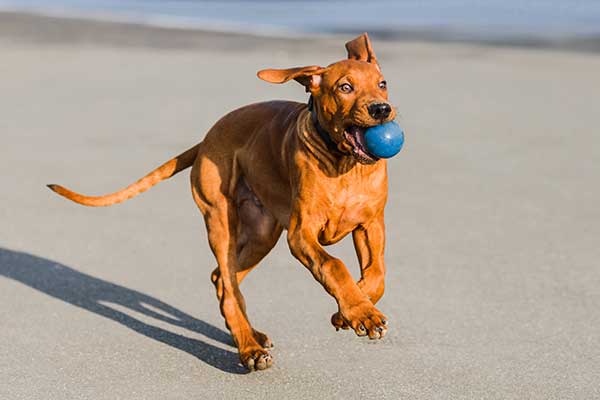Cats and dogs rarely get along well. These pets are known to compete for virtually anything, ranging from territory to food, toys, and even their owner’s attention.
Therefore, it’s natural for any pet parent considering adopting a Rhodesian Ridgeback to wonder whether the dog breed will live harmoniously with his cats.
Unfortunately, the Rhodesian Ridgeback naturally doesn’t get along fine with cats. This dog breed possesses certain personality traits that make it exceedingly difficult to share the same living space with cats. However, there’s an exception to this rule. Your Rhodesian Ridgeback may potentially live together with your cat if the two pets were raised together and socialized early enough. Training may also play a huge role in making your Rhodesian Ridgeback able to coexist with your feline friend.
If you’ve been toying with the idea of bringing a Rhodesian Ridgeback to a household with cats, this article is for you. We’ve prepared a compressive guide on the Rhodesian ridgeback and cats.
But first, let’s begin by familiarizing ourselves with what this dog breed is all about.
Table of Contents
More About Rhodesian Ridgebacks
The Rhodesian ridgeback is a large sighthound and scenthound dog breed developed primarily for hunting and guarding.
The breed was created in the Southern Africa region, particularly in Southern Rhodesia (present-day Zimbabwe).
Rhodesian Ridgeback Quick Facts
| Official Name: | Rhodesian Ridgeback |
| Nicknames: | African Lion Dog |
| Developer: | F. R. Barnes |
| Place Developed: | Bulawayo, Zimbabwe |
| Period Developed: | 1922 |
| Breed Classification: | Working Dog |
| Breed Size: | Large |
| Height at the Withers: | 26 to 29 inches (67 to 74 centimeters) for dogs and 24 to 26 inches (61 to 66 centimeters) for bitches |
| Weight: | 93 to 106 pounds (42 to 48 kilograms) for dogs and 79 to 88 pounds (36 to 40 kilograms) for bitches |
| Coat Characteristics: | Short and dense in texture; sleek and glossy in appearance |
| Coat Color: | Light wheaten to red wheaten, with a bit of white markings on the chest and toes |
| Temperament: | Intelligent, Active, Loyal, Alert, and Eager to Please |
| Common Health Problems: | Hip & elbow dysplasia, dermoid sinus, thyroid issues, and cataracts |
| Average Lifespan: | 10 to 13 Years |
| Year Recognized by the American Kennel Club (AKC): | 1955 |
View this post on Instagram
History
The Rhodesian Ridgeback traces its origin to Bulawayo in Southern Rhodesia (present-day Zimbabwe). Like many dogs, the breed gets its name (the first part of the name) from its origin.
Reports indicate that some of Rhodesian Ridgeback’s ancestors were semi-domesticated dogs originally used by the Khoikhoi for hunting and guarding. These dogs were later interbred with European dogs brought to the South African region by the early colonialists. Examples include greyhounds, bloodhounds, Irish wolfhounds, and Great Danes.
Like his indigenous forbearers, the Rhodesian Ridgeback was developed primarily for hunting and guarding. The Ridgeback enjoyed a reputation for being the only dog able to hunt and defend his owners against marauding lions, thanks to his fearless and ferocious nature.
Locals also used Ridgebacks to ward off boars, bears, baboons, and other wild game that often wandered into human settlements.
F.R Barnes is credited for creating the original breed standard for the modern Rhodesian Ridgeback in 1992. In 1927, Barnes’ ridgeback standard was approved by the South African Kennel Union. The Rhodesian Ridgeback eventually earned The American Kennel Club recognition in 1955.
Physical Features
The Rhodesian Ridgeback is a large working dog breed. Males measure 26 to 29 inches (67 to 74 centimeters) at the withers and weigh 93 to 106 pounds (42 to 48 kilograms) while females measure 24 to 26 inches (61 to 66 centimeters) and weigh 79 to 88 pounds (36 to 40 kilograms).
Ridgebacks sport a short and dense coat, which looks sleek and glossy. Coat colors range from light wheaten to red wheaten. Many Ridgebacks have white markings on their chest and toes too.
However, the Rhodesian Ridgeback’s defining feature is the ridge of hair that stretches along its back, running in the opposite direction from the rest of the dog’s coat. This pretty much explains the ‘Ridgeback’ reference in the dog’s name.
Other notable physical features of the Rhodesian Ridgeback include an athletic body, black nose, and round eyes that usually reflect the color of the dog’s coat.
View this post on Instagram
Do Rhodesian Ridgebacks Get Along With Cats?
Evidently, the Rhodesian Ridgeback possesses unique physical attributes that make him one of the world’s most sought-after breeds. But do ridgebacks get along well with cats?
We’ve already hinted that Rhodesian Ridgebacks may not be the best dog breed for a household with cats. However, to answer this question conclusively, we’ll need to dig deeper into breed’s temperament and personality.
For starters, Rhodesian ridgebacks are fairly smart. The breed inherited his intelligence from his forbearers, which include greyhounds and bloodhounds.
Ridgebacks are remarkably loyal to their owners too. But due to their guarding instincts, the breed may display a bit of aloofness to strangers.
Last but not least, Rhodesian ridgebacks are alert, active, and eager to please.
Why Don’t Rhodesian Ridgebacks Get Along With Cats?
Rhodesian ridgebacks are generally well-mannered dogs who will not attack without sufficient provocation. They’re also intelligent enough to differentiate household members from strangers. However, Ridgebacks have strong predatory instincts. And that’s precisely why they do not get along well with cats.
Like any dog breed originally developed for hunting, the Rhodesian Ridgeback is naturally inclined to respond to anything that moves. Most Ridgebacks will instinctively chase cats due to their strong prey drive. That’s regardless of whether the cat is running or simply walking away. Skittish and rambunctious cats are usually the biggest targets of Ridgebacks’ unrestrained predatory response.
When a Rhodesian ridgeback goes after a cat, the targeted cat is likely to run away out of fear. Unfortunately, that only fuel’s the dog’s prey drive.
The cat may be lucky to climb up a tree or run into a tight corner where the ridgeback cannot access. But what happens if the animal runs out of places to hide? His only option would be to turn the heat on his assailant. And that’s when serious injuries can occur.
Cats may be small and adorable. But when annoyed, these otherwise gentle pets can turn into a rolling ball of razor-sharp paws and teeth. You don’t want to be caught in their path, not even when you’re one of the strongest and most athletic dog breeds.
Size is another major factor that can work against the Rhodesian Ridgeback’s ability to coexist with cats. Most cats find Ridgebacks too intimidating due to the dog’s huge size and athletic build. Even large cats like Maine Coons would still feel frightened by a Ridgeback’s imposing size.
View this post on Instagram
When Might Rhodesian Ridgebacks Get Along With Cats?
It’s important to note that Rhodesian Ridgebacks do not take pleasure in chasing cats because they hate them. Rather, it’s an instinctive response to any fast-moving animal.
Since prey drive is a behavior ingrained in a Ridgeback’s DNA, it can be exceedingly difficult to remove. However, early training and socialization might make a difference.
Whether you’re adopting a mature Rhodesian Ridgeback or anticipating one as part of the family litter, it’s important to get the dog socialized with your cat early enough.
The best way to socialize a Rhodesian Ridgeback with a cat is by taking both pets on your routine walks around the neighborhood. Remember to keep the animals on a leash during their early days of acquaintance. The idea is to make them understand that they both belong in the same household and must, therefore, get along.
Playing together and having joint grooming sessions may also go a long way in getting your Ridgeback and cat to live harmoniously.
If you prefer training your Rhodesian Ridgeback instead, you’ll need to start by teaching the dog basic commands like “SIT,” STOP,” “DOWN,” and “STAY.” You can then bring the animals to a neutral spot (one that neither pet claims as his patch) and allow them to exchange scents.
It’s okay if your Ridgeback and cat avoid physical contact on the first few days. With time, the two animals will become more comfortable in each other’s presence. Don’t forget to reward them for good behavior, using each animal’s favorite treats.
The following tips may also help your Rhodesian Ridgeback and cat share the same living space;
- Set up safe rooms where both the Ridgeback and cat can escape to if they feel threatened; the room should be able to accommodate only one animal.
- Ensure each animal has his own food bowl, feeding spot, litter box, playing patch, and toys.
- Give both animals an equal amount of attention to avoid jealousy-induced rage.
- Never leave your Ridgeback and cat unsupervised.
- Offer both animals sufficient stimulation using toys and physical exercise; this helps release their pent-up energies.
Can Rhodesian Ridgebacks Live With Cats?
Rhodesian Ridgebacks are naturally inclined to chase after anything that moves, which makes it difficult for them to live with cats. But with adequate training and socialization, you can succeed in making your Ridgeback and cat the best of buddies.
Just be sure to never leave the animals unattended for long. Also, ensure both your ridgeback and cat are well-stimulated. This will particularly tire the dog down, making him less inclined to chase after the cat.
View this post on Instagram
Checkout Our Favorite Dog Products
1. BEST PUPPY TOY
We Like: Snuggle Behavior Toy with Heart Beat & Heat Pack – Ideal toy for new puppies.
2. BEST DOG TRAINING PROGRAM
We Like: Doggy Dan The Online Dog Trainer – Stop any dog problem and raise the perfect puppy with The Online Dog Trainer.
3. BEST DOG PUZZLE TOY
We Like: Outward Hound Interactive Puzzle Toy – Every dog loves chasing squirrels at the park. The Outward Hound Hide-a-Squirrel Puzzle Toy gives your dog the same feeling as though he was outdoors chasing live squirrels.
4. Best Bone Broth for Dogs
We Like: (Solid Gold – Human Grade Bone Broth for Dogs) – Simmered Beef Bone Broth With Turmeric Provides A Nutrient-Dense And Flavorful Addition To Your Dog’s Meal + Rich In Natural Collagen From Beef Bones.
5. Best Multivitamin for Dogs
We Like: PetHonesty 10-For-1 Multivitamin – 10 Benefits in 1 Daily Treat – These Multivitamin Snacks combine a well-rounded blend of the most essential vitamins and supplements including glucosamine, probiotics, vitamins and omegas, for dogs’ overall daily health.


